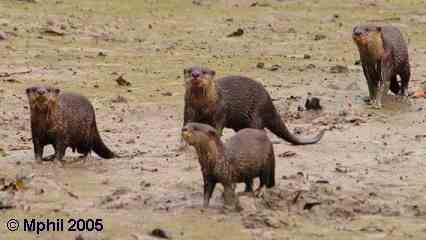Social Behaviour of the Asian Small-Clawed Otter
Territory
Oddly enough for what, in the past, has been such a common animal, little is known of its behaviour in the wild - less than is known about some of the other, rarer Otters. They appear to have some kind of territory or home range, because they have been recorded building mounds of soil or sand for sprainting, re-visiting these points to renew scent. In captivity, they certainly patrol the boundaries of their enclosures and establish spraint points, which each member of the group visits in turn, defaecating, and paddling the spraint into the ground. By analogy with other otters, it an be assumed that territory size and shape is determined by density of other territories, number of animals in the group, amount of prey and availability of resources such as den locations, grooming patches and so on.
Holt
In the wild, despite having only vestigial claws, these animals dig large burrows in muddy riverbanks, often with one entrance above water, thought to act as a ventilation shaft, and a tunnel opening about three feet underwater, which is the main entrance. The whole group sleep together.
Daily Activity
Little is known about their normal schedule in the wild; in zoos this is always manipulated by the keeping regime to keep the animals on show to the public. The little evidence there is suggests that they are naturally primarily diurnal.
Sociability
 This is by far the most social of all the otter species, and one of the reasons
may be that their main food source being invertrebrates, it replenishes rapidly,
thus allowing the animals to cluster together more densely than would be possible
if their dominant food were less quick to replace itself
(Johnson et al, 2000).
An otter family from Pulau Ubin is shown - click on the image for a larger version.
This is by far the most social of all the otter species, and one of the reasons
may be that their main food source being invertrebrates, it replenishes rapidly,
thus allowing the animals to cluster together more densely than would be possible
if their dominant food were less quick to replace itself
(Johnson et al, 2000).
An otter family from Pulau Ubin is shown - click on the image for a larger version.
A pair of otters mates for life, the female being dominant; the young of subsequent years frequently stay with their parents, and extended families of twenty have been seen in the wild, though groups, or Lodges, of four to twelve are more normal. A group may also contain unrelated animals who have joined it. Only the original parents, the alpha pair, breed during their lifetime. When one of the alpha pair dies, the whole group splits up, and the members either find mates and start a new group, or join an existing group as transients. The whole group rests and sleeps together, and frequent allo-grooming is observed. Pellis (1984) observed that the otters, when not foraging or sleeping, are often play-fighting, where the original combatants non-aggressively try to mouth each other's heads and cheeks, and the rest of the group join in, mouthing the tails and legs of the defender. This species seems to derive comfort from having some part of another otter in their mouths, and will often suck each others' tails or paws. 'Playful' behavour has often been observed in the wild. In aggressive bites, on the other hand, the ears are flattened, the lips retracted and there are loud and angry vocalizations. Both playful and aggressive attacks are, however, frequently launched with no visual signals, or warning sounds - this may be an adaptation to being a very small predator, potentially facing much larger ones, where an attack without warning will have the advantage of surprise, especially if the whole group join in. A group of Asian Small-Clawed Otters fights as a unit and even tigers give them a wide berth.
| Asian Small-Clawed Otter |

